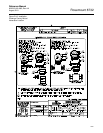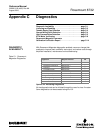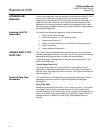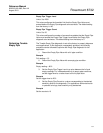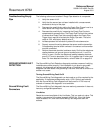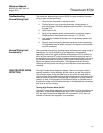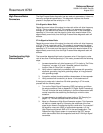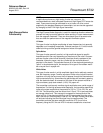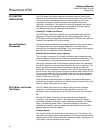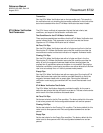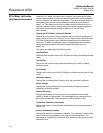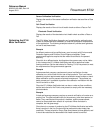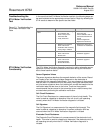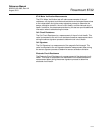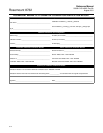
Reference Manual
00809-0100-4665, Rev AA
August 2010
C-7
Rosemount 8732
NOTE
In applications where very high levels of noise are a concern, it is
recommended that a dual-calibrated Rosemount High-Signal 8707 sensor be
used. These sensors can be calibrated to run at lower coil drive current
supplied by the standard Rosemount transmitters, but can also be upgraded
by changing to the 8712H High-Signal transmitter.
High Process Noise
Functionality
The High Process Noise diagnostic is useful for detecting situations where the
process fluid may be causing electrical noise resulting in a poor measurement
from the magnetic flowmeter. There are three basic types of process noise
that can affect the performance of the magnetic flowmeter system.
1/f Noise
This type of noise has higher amplitudes at lower frequencies, but generally
degrades over increasing frequencies. Potential sources of 1/f noise include
chemical mixing and the general background noise of the plant.
Spike Noise
This type of noise generally results in a high amplitude signal at specific
frequencies which can vary depending on the source of the noise. Common
sources of spike noise include chemical injections directly upstream of the
flowmeter, hydraulic pumps, and slurry flows with low concentrations of
particles in the stream. The particles bounce off of the electrode generating a
“spike” in the electrode signal. An example of this type of flow stream would
be a recycle flow in a paper mill.
White Noise
This type of noise results in a high amplitude signal that is relatively constant
over the frequency range. Common sources of white noise include chemical
reactions or mixing that occurs as the fluid passes through the flowmeter and
high concentration slurry flows where the particulates are constantly passing
over the electrode head. An example of this type of flow stream would be a
high consistency pulp stock stream (>10%) in a paper mill.
The transmitter continuously monitors signal amplitudes over a wide range of
frequencies. For the high process noise diagnostic, the transmitter specifically
looks at the signal amplitude at frequencies of 2.5 Hz, 7.5 Hz, 32.5 Hz, and
42.5 Hz. The transmitter uses the values from 2.5 and 7.5 Hz and calculates
an average noise level. This average is compared to the amplitude of the
signal at 5 Hz. If the signal amplitude is not 25 times greater than the noise
level, and the coil drive frequency is set at 5 Hz, the High Process Noise alert
will activate indicating that the flow signal may be compromised. The
transmitter performs the same analysis around the 37.5 Hz coil drive
frequency using the 32.5 Hz and 42.5 Hz values to establish a noise level.



